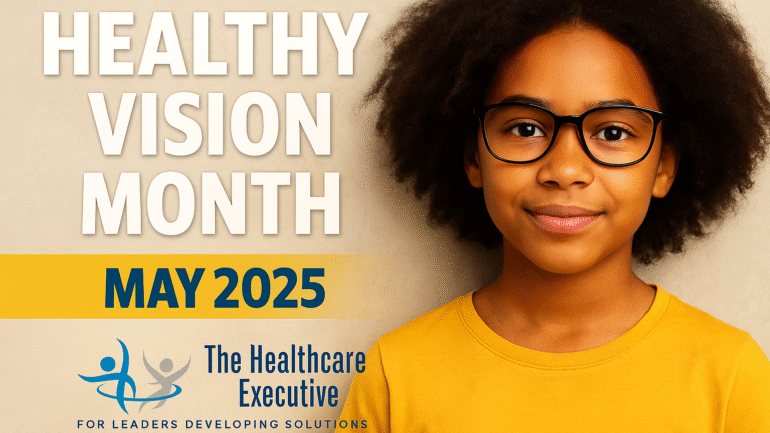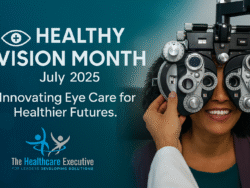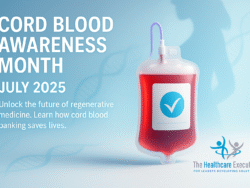Healthy Vision Month – May 2025

- Posted by Greg Wahlstrom, MBA, HCM
- Posted in Health Observance Calendar
Hospital Leadership in Preventive Eye Care and Vision Equity
Published: May 1, 2025
Each May, Healthy Vision Month draws attention to the importance of preventive eye care and equitable vision services for all age groups. According to the CDC, vision loss affects approximately 12 million people over the age 40 in the U.S., and millions more are at risk due to underdiagnosed or untreated eye conditions (CDC Vision Loss Facts). This observance presents a strategic leadership moment for hospitals to prioritize vision screening, integrate optometry and ophthalmology workflows, and address social determinants of vision health. A landmark report from the National Academies called for integrating eye care into broader population health frameworks, emphasizing prevention, early detection, and equitable access to services (NCBI, 2016). Hospital leaders must ensure preventive eye care is embedded across primary care, diabetes clinics, and inpatient discharge planning. Vision loss, if unaddressed, can cause falls, cognitive decline, and reduced independence—placing avoidable burdens on patients and care systems. May offers an opportunity to re-centre vision health as essential to patient safety, population health, and executive strategy.
Embedding vision care into hospital operations demands cross-disciplinary coordination and standardized workflows. Primary care teams should use EHR prompts to identify patients due for routine eye exams and flag high-risk groups like diabetics, older adults, and outdoor workers. Ophthalmology and optometry departments can pilot teleophthalmology tools, such as remote retinal imaging, to expand access for rural patients and reduce unnecessary referrals. Pharmacy and discharge teams should counsel on protective eyewear and ultraviolet risk reduction. Some systems have installed mobile eye clinics at community centers and on-campus health fairs, improving accessibility and awareness. A 2024 study published in Vision highlighted how hospitals that embed coordinated screening, teleopthalmology tools, and outreach strategies can overcome social and geographic barriers to care and improve eye health outcomes (PMC11524801). Quality teams should monitor exam uptake, referral conversion, and outcomes like corrected vision rates. Hospitals that implement vision screening protocols are actively reducing preventable vision loss and preserving patient independence. For example, structured screening in stroke units has been shown to uncover undiagnosed visual impairments, offering a critical intervention point to improve functional recovery and long-term quality of life (NIHR Evidence, 2024).
Vision equity also requires intentional attention on underserved communities. Studies show that low-income populations, racial minorities and rural residents have disproportionately higher rates of undiagnosed glaucoma and diabetic retinopathy, largely due to systemic barriers in access and early screening (ScienceDirect, 2025). Hospitals must ensure language access services, culturally appropriate health education, and sliding-scale vision assistance are embedded in all clinics. Community partners—including schools, senior centers, and farmers’ cooperatives—can help deliver pop-up screening events and service navigation. Medical-legal partnerships (MLPs) are an effective hospital strategy for adressing vision-related disparities by helping patients navigate disability claims, secure workplace accommodations for corrective eyewear, and access public benefits that support long-term eye health (American Hospital Association, 2020). Equipment calibration, quality control, and staff training in vision disparities are essential. Executive dashboards should stratify vision outcomes by race, language, and zip code to identify and close gaps. Prioritizing vision equity reflects both patient-centered care and financial responsibility under value-based models.
Community visibility during May should go beyond posters. Hospitals can host “Ask an Ophthalmologist” webinars, school-based vision fairs, and press outreach on UV safety and occupational eye protection. Leveraging partnerships with organizations like the Prevent Blindness and the NIH National Eye Institute strengthens messaging and credibility. Featuring patient stories—like someone whose early diabetic retinopathy was caught through hospital-linked outreach—personalizes the impact. Internal training for frontline providers to recognize sudden vision changes and initiate urgent referrals enhances clinical response. Reporting these activities in community benefit documents reinforces hospital leadership in public health. Visible executive support during Healthy Vision Month reinforces a long-term commitment to sight-saving services.
As Healthy Vision Month continues through May 2025, hospital executives should convert awareness into accountable clinical action. Leadership teams can set goals around screening rates, follow-up adherence, and vision outcomes. Ophthalmology departments should evaluate resource needs for teleophthalmology, retina specialists, and optometry liaisons. Compliance teams must ensure state-level vision screening mandates are met in ED and school-based partnerships. Budget planning for FY ’26 should reflect investments in portable screening units, diabetic eye exam equipment, and public health outreach. Vision loss is often preventable—but only if hospitals treat it as a strategic priority. When systems lead on eye health, they not only protect patients—they reaffirm their mission of preserving safety, function, and dignity.
Discover More
Looking to embed vision screening protocols and improve eye care service delivery? Our editorial content supports hospital leaders in advancing preventive care, health equity, and interdisciplinary collaboration.
Internal Resources
- National Women’s Health Month 2025: Hospital Equity and Screening Access
- Mental Health Awareness Month 2025: Hospital Response to Silent Crises
External Links
- American Academy of Ophthalmology – Healthy Vision Month
- Prevent Blindness
- NIH National Eye Institute – Eye Health Resources
- Centers for Disease Control and Prevention. Vision Loss and Aging: Vision Loss Facts. Updated October 13, 2023. Available at: https://www.cdc.gov/vision-health/data-research/vision-loss-facts/index.html
- National Academies of Sciences, Engineering, and Medicine; Health and Medicine Division; Board on Population Health and Public Health Practice; Committee on Public Health Approaches to Reduce Vision Impairment and Promote Eye Health; Welp A, Woodbury RB, McCoy MA, et al., editors. Making Eye Health a Population Health Imperative: Vision for Tomorrow. Washington (DC): National Academies Press (US); 2016 Sep 15. 7, Toward a High-Quality Clinical Eye and Vision Service Delivery System. Available from: https://www.ncbi.nlm.nih.gov/books/NBK402378/
- Hepworth, L. R., Rowe, F. J., & VIS Writing Group. (2021). “Eye” Don’t See: An analysis of visual symptom reporting by stroke survivors from a large epidemiology study. Journal of Stroke and Cerebrovascular Diseases, 30(6), 105777. https://doi.org/10.1016/j.jstrokecerebrovasdis.2021.105777
- Rowe, F. J., Hepworth, L. R., Howard, C., Hanna, K. L., & VIS Writing Group. (2020). Impact of visual impairment following stroke (IVIS study): A prospective clinical profile of central and peripheral visual deficits, eye movement abnormalities, and visual perceptual deficits. Disability and Rehabilitation, 43(21), 3026–3033. https://doi.org/10.1080/09638288.2020.1722261
- National Institute for Health and Care Excellence (NICE). (2013). Stroke rehabilitation in adults (Clinical guideline [CG162]). https://www.nice.org.uk/guidance/cg162
- Royal College of Physicians. (2016). National clinical guideline for stroke (5th ed.). London: Royal College of Physicians. https://www.rcplondon.ac.uk/guidelines-policy/stroke-guidelines
- Royal National Institute of Blind People (RNIB). (n.d.). Stroke and sight loss: Information for patients on stroke-related eye conditions. https://www.rnib.org.uk/
- VISION Research Unit. (n.d.). Resources for patients, families, and carers. University of Liverpool. https://www.liverpool.ac.uk/psychology-health-and-society/research/vision/resources/
- Centers for Disease Control and Prevention. (2022, October 25). By the numbers: Diabetes in America. https://www.cdc.gov/diabetes/health-equity/diabetes-by-the-numbers.html
- Elam, A. R., Tseng, V. L., Rodriguez, T. M., et al. (2022). Disparities in vision health and eye care. Ophthalmology, 129(10), e89–e113.
- ElSayed, N. A., Aleppo, G., Aroda, V. R., et al. (2022). 12. Retinopathy, neuropathy, and foot care: Standards of care in diabetes—2023. Diabetes Care, 46(Supplement 1), S203–S215.
- Hemmerich, C., Jones, G., Staggs, J., Anderson, R. M., Bacani, R., & Vassar, M. (2023). Inequities and research gaps in ophthalmology: A scoping review. JAMA Ophthalmology, 141(1), 63–70.
- Rodrigues, G. R., Rao, M. V., Fernandes, M., & Mendonca, T. (2021). Diabetes and vision loss. Diabetic Medicine, 38(1), e14402.
- Wang, W., & Lo, A. C. Y. (2018). Diabetic retinopathy: Pathophysiology and treatments. International Journal of Molecular Sciences, 19(6), 1816. https://doi.org/10.3390/ijms19061816
- Zhang, X., Beckles, G. L., Chou, C. F., et al. (2013). Socioeconomic disparity in use of eye care services among U.S. adults with age-related eye diseases: National Health Interview Survey, 2002 and 2008. JAMA Ophthalmology, 131(9), 1198–1206.
- Zhang, X., Cotch, M. F., Ryskulova, A., et al. (2012). Vision health disparities in the United States by race/ethnicity, education, and economic status: Findings from two nationally representative surveys. American Journal of Ophthalmology, 154(6 Suppl), S53–S62.e1.
- American Academy of Ophthalmology. (2014, December 24). Frequency of ocular examination. https://www.aao.org/education/clinical-statement/frequency-of-ocular-examination
- American Hospital Association. (2020). Medical-Legal Partnerships: A Hospital Strategy for Population Health and Health Equity. https://www.aha.org/system/files/media/file/2020/11/aha-medical-legal-partnerships-1120-final.pdf



